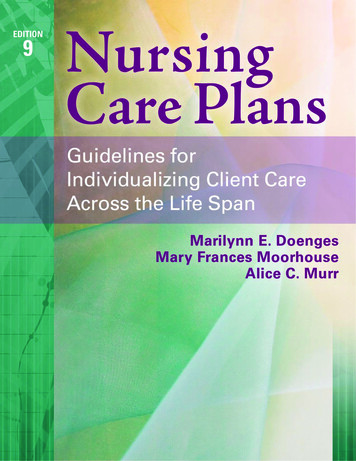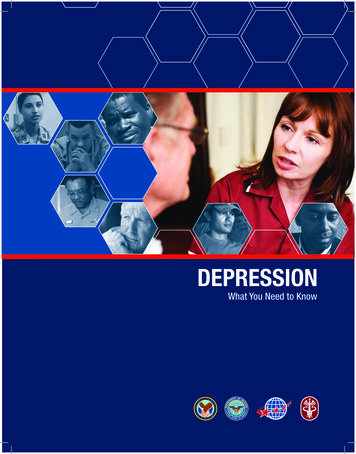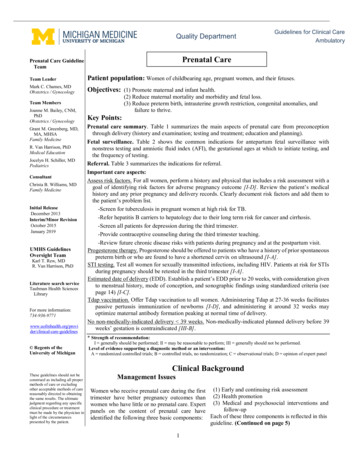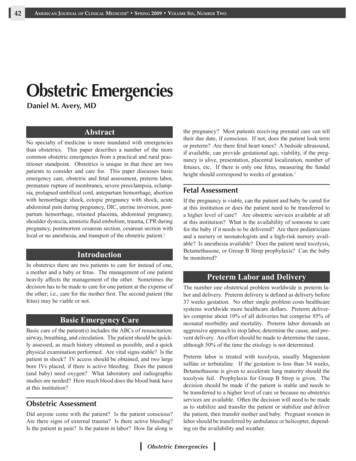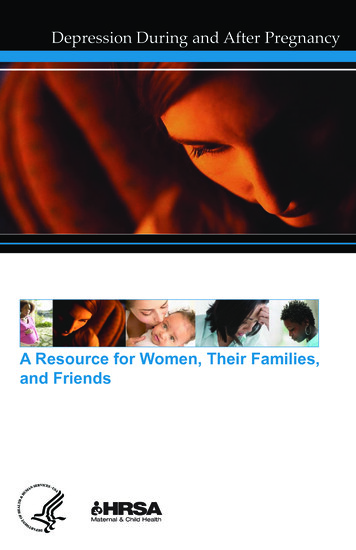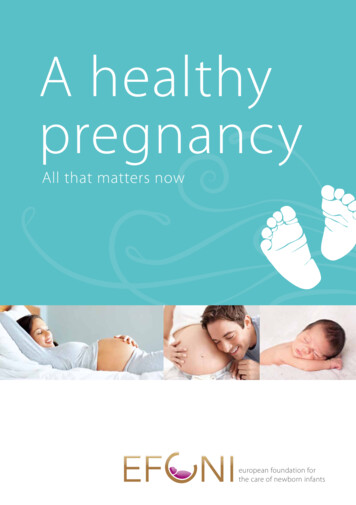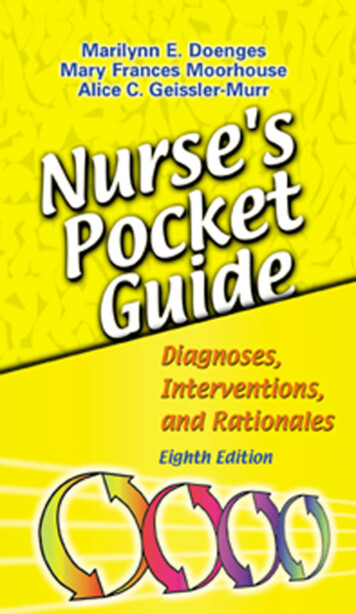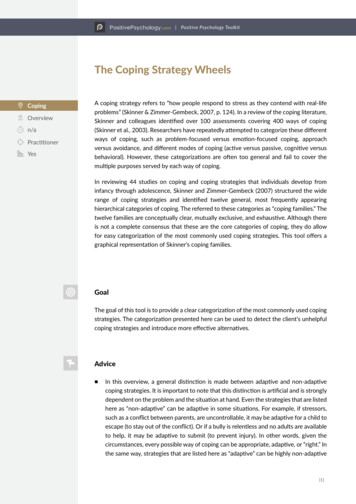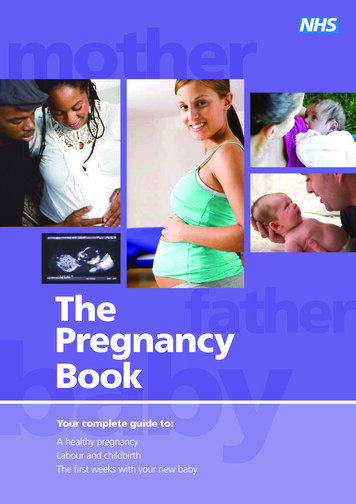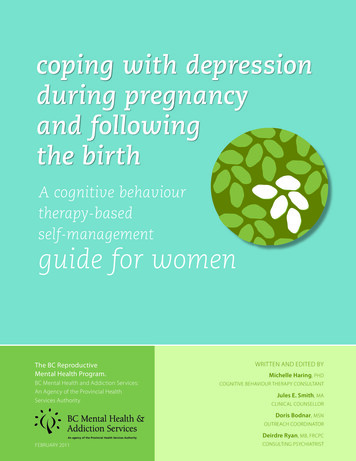
Transcription
coping with depressionduring pregnancyand followingthe birthA cognitive behaviourtherapy-basedself-managementguide for womenThe BC ReproductiveMental Health Program.BC Mental Health and Addiction Services:An Agency of the Provincial HealthServices Authoritywritten AND EDITED byMichelle Haring, PhDCognitive Behaviour Therapy ConsultantJules E. Smith, MAClinical CounsellorDoris Bodnar, MSNOutreach CoordinatorDeirdre Ryan, MB, FRCPCFebruary 2011Consulting Psychiatrist
Coping with depression during pregnancy and following the birth:A Cognitive-Behaviour Therapy-based self-management guide for womenWRITTEN and Edited by The BC Reproductive Mental Health Program. BC MentalHealth and Addiction Services: An Agency of the Provincial Health Services AuthorityMichelle Haring, PhD, Cognitive Behaviour Therapy ConsultantJules E. Smith, MA, Clinical CounsellorDoris Bodnar, MSN, Outreach CoordinatorDeirdre Ryan, MB, FRCPC, Consulting PsychiatristFebruary 2011BC Mental Health and Addictions Services (BCMHAS), an agency of theProvincial Health Services Authority (P HSA), under the Provincial Cognitive BehaviourTherapy InitiativeFunded byDesign AND PRODUCTION bywww.workingdesign.netDownload copies from Reproductive Mental Health Program, a part of BC Mental Health and AddictionsServices (BCMHAS), an agency of the Provincial Health Services Authority (PHSA).www.bcmhas.caBC Partners for Mental Health and Addictionswww.heretohelp.bc.ca.Kelty Resource Centre — located at BC Children’s Hospital, in the Mental HealthBuilding. This provincial resource centre links families with appropriate resourceswithin their health authority.www.bcmhas.ca/supportcentre/keltyBC Children’s Hospital Family Resource rceLibraryOrder hard copies from
contents1 introduction forhealth care providers Why this guide was created 2 What is the bc reproductive mental health program 3 Who is this guide for? 4 How to use this guide 5 We’re looking for feedback 8 Disclaimer 8 Acknowledgements 92 information for womenWhat is depression during pregnancyand following the birth? 2 Learning about the symptoms of depression 2 If I am depressed why do I feel anxious? 4 Why some women develop depression 7 Why some women choose not to seek help 9Coping with Depression During Pregnancy and Following the Birth / page 3
3 getting helpabcTreatment options for women withdepression during pregnancy andfollowing the birth 2 What are the treatment options for depression? 2 How do I choose which treatment is best for me? 3 Using Cognitive-Behaviour Therapy to treat depression 4Cognitive behaviour therapy fordepression during pregnancy andfollowing the birth 8 The Cognitive-Behaviour Therapy model of depression 8 Understanding the connection between different symptoms 11Self-care: The NEST-S program 12 Nest-s 12 Nutrition 13 Exercise 17 Sleep 19 Time for yourself 21 Support 26Coping with Depression During Pregnancy and Following the Birth / page 4
4 actionaMaking positive changes 3bChallenging depressive thinking 24 Goal Setting 3 Learning How to Solve Problems 13 Why is it important to identify and challenge depressive thoughts? 24 What is depressive thinking during pregnancy and following thebirth of your baby? 26 Thinking Traps 27 What is Healthy Thinking? 315 maintaining gains andrelapse prevention Introduction to maintaining gains and relapse prevention 2 Steps to success 2 If you do experience an increase in symptoms 7 What to do if you become pregnant again 7Grace’s story 8 One woman’s journey using this guide 8Coping with Depression During Pregnancy and Following the Birth / page 5
6 handouts for women1. Self-test for depression symptoms in pregnancy and postpartum—Edinburgh postnatal depression scale (epds) 22. The Cognitive-Behaviour Therapy model of depression 43. Goal setting worksheet 54. Thought challenging worksheet 65. Problem solving worksheet 76. Tips for talking with your doctor about your symptoms 87. What your loved ones can do to support you 10Coping with Depression During Pregnancy and Following the Birth / page 6
module 1introductionfor health careproviders Why this guide was created 2 What is the bc reproductive mental health program 3 Who is this guide for? 4 How to use this guide 5 We’re looking for feedback 8 Disclaimer 8 Acknowledgements 9Coping with Depression During Pregnancy and Following the Birth /page 1
module 1introductionfor health careprovidersWhy this guide was createdThis guide was created to help meet the needs of women with depression duringand following the birth.Our goals are to:1. Educate women and health care providers about the signs and symptoms ofdepression before and following the birth2. Educate women and health care providers on the different available treatments.3. Help women to become active participants in their own treatment and recovery,by using specific exercises and other lifestyle changes.Coping with Depression During Pregnancy and Following the Birth /page 2
We bring a wide range of skills to thepreparation of this guide, including bothclinical and research experience.What is the BC Reproductive Mental Health Program?The BC Reproductive Mental Health Program is a multidisciplinary group consistingof psychiatrists, nurse clinicians, psychologists, counselors, dieticians, social workersand researchers who specialize in women’s reproductive mental health andwellbeing. This program is part of the BC Mental Health and Addictions agencyand is located at the Children’s and Women’s Hospitals site in Vancouver, Canada.Together, we have many years of clinical experience working with women and theirfamilies who are dealing with emotional difficulties related to the reproductivelifecycle. We bring a wide range of skills to the preparation of this guide, includingboth clinical and research experience.Contact Details:BC Reproductive Mental Health ProgramMental Health Building, Room P1-2314500 Oak StreetVancouver, CanadaV6H 3N1Tel: 604-875-2025(To reach us toll-free from outside the Lower Mainland, dial1-888-300-3088 to reach the automated switchboard, then enter our local 2025)Fax: ve Mental Health/default.htmWebsite:Coping with Depression During Pregnancy and Following the Birth /page 3module 1
module 1Who is this guide for?For Health Care Providers: This guide may be used by health care providers whowork with women with depression during and following the birth of their baby.We hope that this guide will help women to deal with their symptoms by makingpositive changes in their thinking, behavior and self care and help them to havethe best possible experience during pregnancy and following the birth. Modules 2through 5 in this guide are written in the voice of a healthcare provider talking to thewoman.This guide provides both information and exercises that can be used by yourpatients or clients to help with treatment. Depending on the degree of thesymptoms, this guide can be used by health care providers on its own or incombination with other treatment options such as medication. Health careproviders may choose from the different section(s) of the guide to personalizethe treatment approach. Health care professionals may also want to look atthe companion document that provides tips on how to use this guide whenworking with pregnant and postpartum women in both individual treatmentand group treatment formats.For Women: Thisguide was created for doctors, nurses, mental health workers orother health care providers who are working with women who are suffering fromdepression during and following the birth of their baby. You will most likely want touse this guide with them. In the back are handouts you can use as you work withyour doctor or other health care provider.By using this guide with a trusted health care provider, you have taken the firststeps on an important journey.Be kind to yourself. Change takes time. Your hard work will be of benefit toboth you and your family!Coping with Depression During Pregnancy and Following the Birth /page 4
Use this guide with womenin a way that fits into theircurrent life situation.module 1How to use this guideThe guide is organized into different sections. Health care providers may find ithelpful to discuss with women the sections in the order they appear. However,a certain section (for example, Self-Care: The NEST-S Program) may be moreappropriate for a woman and you may choose to read that part first.That’s OK too. Later on, they may want to discuss all of the sections, as each sectionprovides information and new skills. What’s important is that you use this guidewith women in a way that fits into their current life situation.Also, remember that it is perfectly reasonable to go through this guide withwomen a few pages at a time. It is often a good idea for women to review sectionsthat apply to them, so they have more than one chance to learn everything theyneed to know. A lot of women find that some ideas make sense right away whileothers only sink in after they have been reviewed many times.Most women with depression will find that each of the sections has somethinghelpful to offer – the important thing is to pick something that they feel they canhandle and start the learning process!Coping with Depression During Pregnancy and Following the Birth /page 5
module 1Overview of this guideThis guide is divided into several sections. Each section can be read on its own.The What is depression during pregnancy and following the birth? sectionprovides some basic information about depression in general, what we know aboutdepression occurring in this specific period, and why some women may developdepression during this time.The Getting help: Treatment options for women with depression duringpregnancy and following the birth section describes what we know abouteffective treatments for depression. It also provides an overview of CognitiveBehaviour Therapy – the effective treatment approach that is the basis for thisguide.Cognitive-Behaviour Therapy for depression during pregnancy and followingthe birth goes into further detail about the Cognitive-Behavioural Therapy modelof depression and the relationship between different symptoms. You may want todiscuss with women how to share the information in these sections with supportpeople in their life who are interested in learning more.Self-care: The NEST-S program section provides some basic information forwomen about taking care of themselves. Having depression and being a newmother both tend to interfere with doing things that help them to feel well andaccomplish important goals. This section provides some lifestyle tips that will helpthem to “recharge” themselves and give them the energy they need to practice theeffective depression management skills covered in this guide.The Making positive changes section outlines how women can set and completegoals and steps for learning how to solve their problems. Women may wish toreview the information in this section with support people in their life who canhelp them in this process.The Challenging depressive thinking section introduces four steps you can teachwomen to help them identify and challenge their negative thinking. This sectionalso provides information on managing depressive thoughts including common“traps” and steps that women can take to practice more accurate and helpfulthinking.Coping with Depression During Pregnancy and Following the Birth /page 6
Keep their depression managementskills sharp over the long termmodule 1The Maintaining gains and relapse prevention section helps you teach womento make a plan for how they will maintain the progress that they have made andkeep their depression management skills sharp over the long term. This sectionis most useful once they have been successfully applying the skills taught in thisguide for at least a few weeks.The Handouts for women Section contains forms that women may want to fill outas you go through the guide with them. There are reminders in the guide to let youknow when there is a worksheet that might be helpful for the woman. This sectionincludes:a. The Edinburgh Postnatal Depression Scale (a self-test for depression symptoms)b. Worksheets to help women as they work through each of the skills sections(The Cognitive Behaviour Therapy Model of Depression, Setting SMART goals,Healthy Thinking Form, and Problem Solving Worksheetc. Additional Resources that women and their support people may find useful.These include: Tips for talking with your doctor about your symptoms What your loved ones can do to support youCoping with Depression During Pregnancy and Following the Birth /page 7
module 1We’re looking for feedbackWe would like to hear about whether or not this guide has been helpful in yourtreatment with women. We are open to your suggestions about any changesthat you think could make this guide more helpful for women. Please contactReproductive Mental Health, BC Mental Health and Addictions, C&W. Futurerevisions of this guide will rely on your responses.DisclaimerThe information in this guide is not intended to provide or substitute for,professional medical or other health services. This guide focuses on self-careand cognitive behavioral strategies for the treatment of depression during andfollowing the birth. This does not take away from our support for the use of certainmedications for treating depression. This guide does not include everything thatone should know about depression and treatment. Readers need to know that thereis no single correct approach for the treatment of depression.Coping with Depression During Pregnancy and Following the Birth /page 8
module 1AcknowledgmentsThis guide has been developed in part by adapting previous work that hasbeen published on depression and mood disorders. We have done our best toacknowledge in the text where material has been borrowed from other work. Inaddition, the authors would like to acknowledge the following publications thatwere used as key resources in the development of this guide: The Antidepressant Skills Workbook. Dan Bilsker and Randy Paterson,Centre for Applied Research in Mental Health & Addiction (CARMHA), SimonFraser University. Vancouver, BC 2005. Available on line at kbook/ Anxiety Disorders Tool Kit. BC Partners for Mental Health AddictionsInformation, Vancouver BC, 2003. Available on-line at http://www.heretohelp.bc.ca/publications/toolkits BCP Here to Help: Problem Solving & Healthy Thinking Wellness Modules.BC Partners for Mental Health Addictions Information, Vancouver BC, 2004-2005.Available on-line at eingThe authors would also like to acknowledge these sources that were consulted inthe development of this guide: Diagnostic and Statistical Manual of Mental Disorders, Fourth Edition, TextRevision. Washington DC, American Psychiatric Association, 2000 Mind Over Mood: Change How You Feel by Changing the Way You Think.Dennis Greenberger and Christine A. Padesky. Guilford Press, New York, NY, 1995. Postpartum Depression and Anxiety: A Self Help Guide for Mothers. PacificPost Partum Support Society, Vancouver BC, 1997. www.postpartum.org , 604-2557999. The Feeling Good Handbook, Revised Edition. David D. Burns. Plume, NewYork: NY, 1999. When Baby Brings the Blues: Solutions for Postpartum Depression. ArielDalfen. John Willey & Sons Canada, Ltd, Mississauga, ON, 2009.Coping with Depression During Pregnancy and Following the Birth /page 9
module 1Acknowledgments continuedWe also thank the nurses, doctors, counselors and women across BC who haveprovided helpful suggestions during the development of this document. Thanks toDr. Sarah Newth, on behalf of Anxiety BC who wrote the original Anxiety DisordersTool Kit. A special thanks to Gillian Albert our Research Assistant for the ProvincialPerinatal Cognitive Behaviour Therapy initiative.Coping with Depression During Pregnancy and Following the Birth /page 10
module 2informationfor womenWhat is depression during pregnancyand following the birth? Learning about the symptoms of depression 2 Signs and symptoms of depression The difference between the “baby blues” and depression? If I am depressed why do I feel anxious? 4 Signs and symptoms of anxiety Harm thoughts Why some women develop depression 7 Risk factors for becoming depressed Why some women choose not to seek help 9Coping with Depression During Pregnancy and Following the Birth /page 1
module 2informationfor womenWhat is depression during pregnancy andfollowing the birth?Learning about the symptoms of depressionDepression during pregnancy and following the birth of the baby affects a woman’smood, behaviour, thoughts and physical well-being. A woman who is experiencingdepression will often feel down, sad or empty and may lose interest in activities thatshe usually enjoys. Other common signs and symptoms are listed in the box on thenext page.Coping with Depression During Pregnancy and Following the Birth /page 2
module 2Signs and symptoms of depressionFeelings feeling depressed or extremely sad most of the day nearly everyday feeling irritable or angry feeling very guilty or worthless feeling hopeless feeling overwhelmed not enjoying the baby not interested in or able to enjoy activities that you used to enjoyBehaviours sleeping a lot more or less than usual eating a lot more or less than usual withdrawing from family, friends and social contactPhysical Symptoms crying for no apparent reason feeling restless having little energy having difficulty concentrating or making decisions having physical symptoms like headaches or upset stomachThoughts having thoughts that you are a ‘bad’ or ‘terrible’ mother having frightening thoughts including harming yourself and/or the babyCoping with Depression During Pregnancy and Following the Birth /page 3
module 2Depression during pregnancy and following the birth may be diagnosed by ahealth care professional if these symptoms last for more than two weeks, aredistressing to the woman and/or make it difficult for her to carry out her dailyactivities, especially the demanding tasks involved in caring for an infant. Althoughthe exact number of women affected by depression during pregnancy andfollowing the birth is not known, research suggests that around 8-12% of pregnantwomen and 10-16% of women are affected by depression after having the baby.What is the difference between the “baby blues” and depression? The “babyblues” are experienced by approximately 80% of mothers within the first few daysafter the birth. Symptoms may include mood swings, crying, worrying, irritability,feelings of helplessness, sadness, anxiety and difficulties sleeping. In most cases,these symptoms resolve or improve on their own within a week or two and do notrequire treatment. However, if these symptoms last for more than two weeks orsignificantly affect the mother’s ability to carry out her daily activities, the mothermay be experiencing depression.If I am depressed, why do I feel so anxious?Many women who experience depression during pregnancy or following thebirth will also have symptoms of anxiety. These range from excessive worries tooverwhelming panic attacks. Having additional symptoms of anxiety may besomething that makes depression during this time different than depression atother times in a woman’s life. However, a woman may experience symptoms ofanxiety during pregnancy or following the birth without being depressed.For some women, these symptoms of anxiety may be more of a problem than thesymptoms of depression. If this is true for you, please talk with your health careprovider about resources that are available for managing your anxiety.Only a health professional can diagnose depression. If you think that youmay be depressed, it is important that you talk to a health professionalabout your symptoms. You may want to complete the Edinburgh PostnatalDepression Scale in Module 6 and take this information with you when yougo to your doctor. You may also want to see the section “Tips for Talking withyour Doctor about your Symptoms”.Coping with Depression During Pregnancy and Following the Birth /page 4
module 2Signs and symptoms of anxietyFeelings feeling fearful, scared, upset or “on guard” irritability feeling keyed up or on edgeBehaviours excessively repetitive behaviours (e.g., cleaning or washing) avoiding people, places or activities excessive checking or reassurance seeking or online ‘research’Physical symptoms trembling, twitching or feeling shaky restlessness becoming easily tired difficulty concentrating or mind going blank trouble falling or staying asleep gas, constipation or diarrhea being easily startled shortness of breath or smothering sensations racing and/or pounding heart sweating or cold clammy hands dizziness or lightheadednessThoughts re-occuring thoughts or images of harm to the baby unrealistic or excessive worry about the baby or other topicsCoping with Depression During Pregnancy and Following the Birth /page 5
module 2A special note about harm thoughtsThe most disturbing thoughts experienced by a mother who is depressed oranxious may include fears or images of harm occurring to her baby either byaccident or through her own actions (e.g. drowning the baby while bathing,dropping the baby over the balcony or stabbing the baby with a knife). Inmost cases the woman feels frightened by these thoughts and would neverwant to do anything to hurt her baby or act on these thoughts. However shemay have difficulty telling anyone that she is having these thoughts when infact they are common to new mothers. If this is true of you it is important totalk to your health care provider so that you can get the help you need.Psychosis following the birthIn extremely rare cases, some women will develop psychosis after thedelivery of their baby. Symptoms include extreme confusion, hopelessness,inability to sleep, distrust of other people, seeing things or hearing thingsthat are not there and thoughts of harming oneself, one’s baby or others.Women with a prior history of bipolar disorder or other psychiatricillnesses, like schizophrenia, may be at higher risk of developingpostpartum psychosis. If this happens to you, it is important that youcontact a health care professional immediately.Coping with Depression During Pregnancy and Following the Birth /page 6
There are a lot of challengesand changes during this timemodule 2Why do some women develop depression during pregnancyor following the birth?Many women are surprised and disappointed when they find themselves feelingdepressed during their pregnancy or following the birth of their baby. After all, mostpeople expect this time to be a joyous one — and for some women it is. But thereare also a lot of other challenges and changes that can make depression more likelyduring this time than at other times in a woman’s life. These include: Changes in relationships with partner, family and friends. Significant role changes in becoming a mother. Leaving work or maternity leave. Lifestyle changes often including more financial pressures. Fatigue and not having enough sleep. Challenges of caring for a new baby along with other responsibilities. Significant physical changes to a woman’s body (e.g., weight gain, changes to thebreasts). Significant changes in hormone levels.Therefore, even if everything goes “as planned” with the pregnancy, birth and firstfew months of the baby’s life, these changes and challenges can make a womanvulnerable to depression.Also, some women who have previously taken medications for depression or anxietymay choose to stop taking their medications prior to or during pregnancy, in somecases, this may lead to an increase in anxiety symptoms during pregnancy and thepostpartum.Coping with Depression During Pregnancy and Following the Birth /page 7
module 2A woman is at higher risk of developing depression duringpregnancy or following the birth of the baby if she Has had depression or anxiety in the past. Has taken medication for depression or anxiety and stops before/duringpregnancy. Has family member(s) who have had depression or anxiety. Has problems in her relationships with partner, friends and family. Experienced or is experiencing violence and/or abuse. Has poor practical and/or emotional support from friends, family andcommunity. Her or others around her have unrealistic expectations of herself as a mother. Finds herself alone a lot of the time and/or separated from loved ones. Has immigrated to Canada within the last 5 years. Has a low income, education, lack of adequate housing or employment. Has had a recent stressful life event (e.g., death of a parent, housing issues). Relies on alcohol, drugs or other substances to help her deal with things. Has had a complicated pregnancy and/or birth. She or her baby had or have health problems.Coping with Depression During Pregnancy and Following the Birth /page 8
module 2Why some women choose not to seek helpUnfortunately, many women who are dealing with depression during pregnancy orfollowing the birth of their baby do not seek treatment for various reasons: She may not know who to talk to. She may not have a health care provider. She may be reluctant to talk to her doctor for a variety of reasons. For example,she may think that these symptoms are not something that you share with adoctor, or that her doctor will not have time. She may be ashamed of her difficulties, worried about being labeled or seen as a“bad” or “unfit” mother or having her baby taken from her. Other people in her life may discourage her from seeking help. This may happenin families that believe that mental health problems are shameful or in families inwhich there is emotional control or abuse.Any of the above situations and other obstacles can make it difficult for a womanto seek help.Where can I get more information, resources and support fordepression during pregnancy or following the birth of my baby?For more information including online resources and books, Google us at“reproductive mental health Vancouver resources”.Coping with Depression During Pregnancy and Following the Birth /page 9
module 3getting helpa Treatment options for women withdepression during pregnancy andfollowing the birth What are the treatment options for depression? 2 How do I choose which treatment is best for me? 3 Using Cognitive-Behaviour Therapy to treat depression 4 What is Cognitive-Behaviour Therapy (cbt)? Using this guide to learn effective self-management skills Overview of Cognitive-Behaviour Therapy for depressionbCognitive-Behaviour Therapy fordepression during pregnancy andfollowing the birth The Cognitive-Behaviour Therapy model of depression 8 Understanding the connection between different symptoms 11cSelf-care: The NEST-S program Nest-s 12 Nutrition Exercise Sleep131719 Time for yourself Support2126Coping with Depression During Pregnancy and Following the Birth / page 1
module 3getting helpaTreatment options for women with depressionduring pregnancy and following the birthWhat are the treatment options for depression?There are several approaches that have been shown to help women withdepression. These may include: Guided Self-Management: Involves regular appointments with a health-careprofessional who provides support and structure when using print or onlineresources such as this self-management guide. Psychotherapy: Although there are many different types of psychotherapy,the ones that have been shown by research studies to be most effective for thetreatment of depression during pregnancy and following the birth are CognitiveBehaviour Therapy (CBT) and Interpersonal Psychotherapy (IPT). These types oftherapy involve regular appointments with a health care professional who providespsychological treatment for depression. Treatments may be provided individuallyor in a group setting. It is a good idea to make sure that your health care providerknows about and has experience with treating women who are depressed duringpregnancy and following the birth of a child. Medications: Medications treat the symptoms of depression at a chemicallevel. The most commonly used medications are antidepressants such as selectiveserotonin reuptake inhibitors (SSRIs) or serotonin and norepinephrene reuptakeinhibitors (SNRIs). Antidepressant medications work by increasing the level ofcertain neurotransmitters in the brain. These medications have been shown tosignificantly lower symptoms for some people suffering from moderate to severedepression. For more information refer to page 5 of this module.With appropriate care, many women can decrease their symptoms and start toenjoy pregnancy and the months following the birth. Treatment may also reducethe risk for future episodes of depression.Coping with Depression During Pregnancy and Following the Birth /page 2
module 3How do I choose which type of treatment is best for me?The decision about which type of treatment is best for a specific woman dependsupon a number of things, including the seriousness of her symptoms, how thewoman feels about different treatment options, and the availability of these differenttreatment options within her community. Some treatments, such as specializedtherapies like Cognitive-Behaviour Therapy or Interpersonal Psychotherapy may notbe available in all communities. In some communities, medications may be the onlyavailable treatment for depression during pregnancy or following the birth. Somewomen, with help from a health professional, will choose to use both psychologicaltreatment and medication to manage their depression.It is a good idea to
effective treatments for depression. it also provides an overview of Cognitive Behaviour therapy - the effective treatment approach that is the basis for this guide. Cognitive-Behaviour Therapy for depression during pregnancy and following the birth goes into further detail about the Cognitive-Behavioural therapy model

